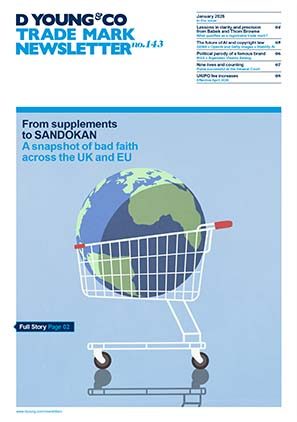Bent(ley) out of shape in trademark dispute
In Bentley 1962 Ltd v Bentley Motors Ltd ([2019] EWHC 2925 (Ch)), the High Court has found Bentley Motors to have infringed trade marks belonging to a small UK-based clothing company. While not a landmark case, the decision highlights the importance of trade mark registrations for even the smallest of businesses.
Background
Collectively called “Bentley Clothing”, the two claimants consisted of Bentley 1962, the owner of the rights in issue, and Brandlogic, a family-run firm selling clothes under the brand BENTLEY. Bentley Motors is the famous manufacturer of luxury vehicles.
Bentley Clothing could trace its use of the BENTLEY sign on clothing back to 1962, and additionally owned three UK trade marks for BENTLEY, each registered for goods in class 25, including a figurative mark, a series mark and a word mark.
Bentley Motors used the device shown below (called the “combination sign”, being two elements: the word “Bentley” and the “B-in-Wings” device) on clothing and headgear, which formed the basis of Bentley Clothing’s complaint.

Judgment
The central question for the court was to determine whether the average consumer would perceive Bentley Motors’ use of the combination sign on clothing as being one sign or two, ultimately impacting on whether there could be double identity infringement of the BENTLEY trade mark(s) or whether the combination sign was confusingly similar (or both).
In relation to Section 10(1) of the Trade Marks Act 1994, Bentley Motors agreed that if the combination sign was perceived as two separate signs, there would be double identity infringement of the BENTLEY word and series mark. The judge was shown various licencing agreements, swing tags and terms and conditions from 2005 onward. He found that Bentley Motors themselves likely considered the elements as two separate signs until 2014, after which brand guidelines said that the two signs would be used together “from now on”. The judge held that the average consumer in the early 2000s would have come to this conclusion naturally as a result of Bentley Motor’s previous use of the separate elements and likely after 2014 as well, as the consumer would not be aware of Bentley Motors’ brand intentions and the elements continued to be used as separate signs after that date.
The judge therefore found that there had been double identity infringement of the BENTLEY trade marks.
Despite having found infringement, the judge considered whether there was likelihood of confusion under Section 10(2) of the Trade Marks Act 1994 in any event.
Bentley Motors argued that, from at least 2002, the average consumer would only think of Bentley Motors and not Bentley Clothing when seeing clothes with the combination sign, given the significant reputation it enjoyed. On assessment, referencing Maier ([2015] EWCA Civ 220), the judge confirmed that the court must assume a notional and fair use of the registered trade mark, meaning that Bentley Clothing’s modest use of the marks to that point was irrelevant. The court then held that the dominant component of the combination sign is the word
BENTLEY and would therefore lead to a likelihood of confusion.
The first of two defences that Bentley Motors ran was a technical one. Under the transitional provisions of the Trade Marks Act 1994, it is a defence to infringement where the act is a continuing one and was lawful prior to the 1994 Act, but rendered unlawful subsequently. In this case, under the old law, goods or services sold not otherwise covered under a registered trade mark would be considered lawful.
Prior to 1994, Bentley Motors sold jackets, silks, ties, caps and scarves in a catalogue marked “The Bentley Selection”, none of which were covered under the relevant mark. The judge held that Bentley Motors could continue this practice. Bentley Motors, however, sought to rely on this provision as a wider defence to infringement. In their view, the word BENTLEY is the dominant element of both “The Bentley Selection” sign and the combination sign, which amounts to a continuation of its use of “The Bentley Selection” sign.
The judge disagreed. He held that it was clearly not the intention of Parliament to allow a party to branch out into new uses of the sign by permitting use of a different mark in relation to a wider scope of goods.
The second defence of honest concurrent use was equally unsuccessful. The judge considered the evidence whether Bentley Motor’s behaviour was consistent with honest use, or whether it encroached on Bentley Clothing’s goodwill by taking steps to “exacerbate the level of tolerable confusion”.
The court concluded that whilst there had initially been honest and concurrent use of the combination sign, this ceased to be the case as there was a clear pattern of encroachment, in particular because, since at least 2000, Bentley Motors had deliberately made incrementally increasing use of the sign to avoid raising the ire of Bentley Clothing.
Case details at a glance
Jurisdiction: England & Wales
Decision level: High Court
Parties: Bentley 1962 Limited and Brandlogic Limited (claimants) and Bentley Motors Limited (defendant)
Date: 01 November 2019
Citation: [2019] EWHC 2925 (Ch)
This article (in shortened format) first appeared on WTR Daily, part of World Trademark Review, in November 2019. For further information, please see www.worldtrademarkreview.com.
Read more